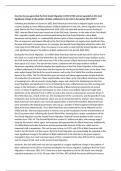How far do you agree that the First Great Migration (c1910-1930) can be regarded as the most
significant change in the pattern of black settlement in the USA in the period 1850-2009?
Following the abolition of slavery in 1685, Black Americans were free to migrate legally across the
country, leading to many different phases of Black settlement in the USA, where migration was at its
peak. Before the First Great Migration from 1910-1930, the slow drift north occurred, starting in
1865, wherein Black Americans moved out of the Old South. However, in the wake of the First World
War, migration rapidly sped up and increased during the First Great Migration, many Black
Americans moving North, in a substantially shorter space of time compared to the slow drift North.
The consequences and impact offered by the First Great Migration are largely more significant than
the slow drift north’s consequences, for example, the Second Great Migration which later led to the
move back to the Old South. Thus, this means it is accurate to state that the Great Migration was the
most significant change in the pattern of Black settlement in the period 1850-2009.
During the First Great Migration, 1.6 million Black Americans left the south-east of the USA to live in
the north as a result of the First World War. By 1930, Black Americans lived in large numbers across
the USA, north and south, with more than 10% of the country’s Black Americans moving North in the
short space of 15 years. The narrow time frame, compared with the large numbers of Black
Americans migrating, effectively displays the significance of the First Great Migration in the pattern
of Black settlement as it shows how vital the reasons for moving to the North were at the time. They
were pulled toward the North for several reasons, such as the First World War and the economic
boom of the 1920s. The First World War gave rise to job and labour opportunities to help fund the
US production of armaments. These opportunities were taken up by many Black Americans in hope
of escaping from a life of poverty, having higher wages and a better life, displaying how the First
Great Migration was significant in terms of bettering the lives of Black Americans after earning poor
wages in the Old South. In addition to this, thousands of Black Americans joined the US armed
forces, in which its significance and impact are seen in how several Black regiments fought with
distinction on the Western Front in 1918. As well as this, America witnessed an economic boom in
the 1920s that was a result of the war, the development of the car industry, and the growth of mass
production. Due to this development, there was an increased demand for workers, thus meaning
Black Americans were given even more job opportunities in the North and West. Black Americans
were assisted by the federal government, who set up a number of federal agencies through which
Black Americans obtained jobs. Thus, Black Americans had continued the Great Migration of the
1920s and 30s. The booming economy in America set up the foundations for the transformation of
the US economy later, following the Second World War, showing how a major consequence of the
First Great Migration was the Second Great Migration. National income doubled in the 5 years of
wartime from 1941-45. The Second World War created 17 million new jobs, with average wages
rising by 30 percent, which, again, led to greater job opportunities for Black Americans. Additionally,
15 million Black and white Americans moved permanently because of the war, which was an
important shift in population. This can be seen in how, by 1970, only 53% of Black Americans still
lived in the Old South. For this reason, the First Great Migration can unmistakably be regarded as the
most significant change in the pattern of Black settlement in the USA due to the great impact it
managed to have in a much narrower space of time, compared to the slow drift north for example,
and the impact it had, such as the Second Great Migration.
However, the slow drift north can also be regarded as a largely significant change in the pattern of
Black settlement in the USA as it laid the foundations for future migration, leading to the First Great
Migration. In the years 1815-1917, there was a slow migration out of the Old South: even though
migration took place, by 1910, 50 years after Civil War, 89% of Black Americans still lived in former




